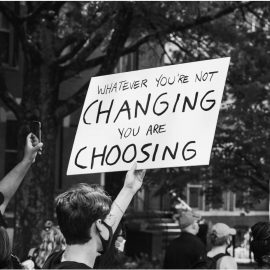

This article is an excerpt from the Shortform book guide to "The White Man's Burden" by William Easterly. Shortform has the world's best summaries and analyses of books you should be reading.
Like this article? Sign up for a free trial here .
How did humanitarian aid help Africa during the AIDS crisis? Could have the crisis have been handled better?
In his book The White Man’s Burden, economist William Easterly believes that the AIDS crisis could have been dealt with more effectively if the humanitarian aid programs had focused more on prevention and less on treatment. This stance is controversial because the utilitarian viewpoint basically ignores those who are already sick.
Continue reading to learn about Easterly’s take on the AIDS crisis.
The 1980s AIDS Crisis
Easterly writes that public health is one area where international aid actually has achieved real, measurable success, possibly because it is a subject that lends itself well to defining clear goals and measuring direct impact—in terms of vaccines administered, patients treated, new hospitals built, and other metrics. However, he adds that public health is where the international aid community has also suffered some of its greatest public failures.
Easterly writes that the AIDS crisis in Africa has been one of the world’s greatest humanitarian disasters since the 1980s. He argues that the aid community’s response to the AIDS pandemic has been marred by the same utopian, top-down, impractical thinking that has compromised its efforts elsewhere.
| Explaining the Higher Rate of HIV/AIDS Infection in Africa The numbers show the true scale of the AIDS catastrophe in Africa—and the devastating price humanity has paid for the world’s failure to properly address it. In the small African nation of Botswana, a full 40% of sexually active adults are HIV-positive, with similar figures in other sub-Saharan countries. By contrast, the rate of infection among sexually active adults in the US is around 1%, with similarly low rates in countries from Russia to India to Thailand. Experts continue to be perplexed by the extraordinarily high infection rates in Africa, given that Africans do not appear to use intravenous drugs, participate in promiscuous sex, or engage in prostitution—all well-documented risk factors for HIV/AIDS—at higher levels than people in other parts of the world. Some researchers suggest that the greater social tolerance for men in African nations from South Africa to Uganda to Botswana to engage in multiple, simultaneous, long-term sexual relationships could be the explanation. This is because a single act of intercourse with an HIV-positive individual is relatively unlikely to spread the virus—between 0.1% and 1%. But in a long-term sexual relationship with repeated sexual encounters (and thus, exposure to the virus), the likelihood of infection will be far greater. |
Focusing Too Much on Treatment, Ignoring Prevention
Much of the response to AIDS in Africa today is focused on helping HIV-positive people access antiretroviral drugs that are used to treat the symptoms of the virus. However, Easterly argues, these HIV/AIDS treatments are simply not cost-effective in Africa—and the disproportionate emphasis placed on them reflects misguided utopian thinking on the part of the aid community.
The drugs are too expensive to be able to distribute in impoverished African countries on a wide enough scale. Moreover, an effective treatment regimen entails not just the drugs, but also a comprehensive set of services that, once again, is beyond the capabilities of the aid agencies to build from scratch in countries often lacking the most basic public health infrastructure.
Finally, Easterly argues, the drugs won’t prevent most AIDS deaths anyway—at best, they might prolong a patient’s life by a few years.
Easterly attributes the inefficient focus on treatment drugs to grandiose, heroic, and glamorous ideas about “solving” or “curing” the AIDS crisis in Africa. In fact, prevention would be far more cost-effective.
Even today, he writes, the foreign aid community is inordinately focused on treatment. Much of this is purely political—highly effective (and cost-effective) prevention measures like sex education and condom distribution are politically controversial (and less impressive), while distributing medication is relatively uncontroversial (and generates glowing publicity and accolades)
| Harm Mitigation and Needle Exchange Programs Sex education and condom distribution to combat the spread of HIV are not the only effective and practical harm-mitigation measures to suffer from a misplaced emphasis on “perfect” solutions. Like those measures, needle exchange programs—in which intravenous drug users can obtain free and safe needles and syringes and discard used needles and other paraphernalia without fear of arrest or harassment—have proven to be highly effective at reducing the spread of bloodborne diseases like hepatitis C and HIV, and they help connect addicts with treatment programs. Cities in states from Vermont to California have implemented such programs, with notable success: CDC data shows that users of needle exchange programs and safe injection sites are five times more likely to enter drug treatment and about three times more likely to ultimately stop using drugs than those who never use such programs. However, the stigma and backlash that such programs generate—usually borne of misguided fears that they encourage or legitimize drug use—has created political pressure to shut these facilities down in states from West Virginia to Indiana and shift toward more “zero tolerance” policies, even as the opioid epidemic rages out of control. |
Diversion of Resources
Besides being ineffective, Easterly argues that big, publicity-grabbing health crises like AIDS divert much-needed resources and attention away from other sources of death and misery on the African continent that could often be treated more effectively and cheaply.
He argues that there is no legitimate moral case to be made for prioritizing the suffering of AIDS patients (nearly all of whom, unfortunately, will soon die of the disease with or without treatment) over that of people suffering from maladies like diarrhea, malaria, and intestinal worms. While these latter diseases do not command the attention of the global public and media the way AIDS does, they do kill millions of people each year. However, unlike AIDS, they are all highly treatable with inexpensive medicines.
Easterly argues that the disproportionate use of resources and attention focused on AIDS is both inefficient and inhumane, because it diverts money from an area where it would make a meaningful difference (treating diseases like malaria and diarrhea) to one where it almost certainly won’t (treating AIDS patients). Refocusing resources on these sources of suffering would both give the aid community a far greater return on its investment and result in millions of lives saved.
The international aid community has to do a better job of making difficult choices about how best to prioritize and allocate scarce resources.
| The moral argument that Easterly is making when he advocates prioritizing the treatment of malaria and diarrhea over HIV/AIDS is utilitarianism. Utilitarianism is a moral school of thought, founded by the English philosopher Jeremy Bentham (1748-1832) that is concerned primarily with final outcomes. Utilitarian thought teaches that any action that maximizes human happiness is the morally correct one. Thus, it would be morally correct to let one person die in order to save the lives of 10 others. If we apply utilitarianism to the arguments that Easterly is making, it would be morally indefensible to use medical resources to prolong the life of one AIDS patient—or even, hypothetically, to save that one patient—if it came at the cost of letting 10 malaria patients die who would otherwise live. |

———End of Preview———
Like what you just read? Read the rest of the world's best book summary and analysis of William Easterly's "The White Man's Burden" at Shortform .
Here's what you'll find in our full The White Man's Burden summary :
- How the global humanitarian aid system is fundamentally flawed
- Why bottom-up aid models work much better than top-down models
- Why the West can't change bad governments






